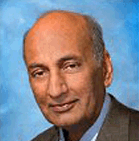Inductee Profile
Praveen Chaudhari
 Praveen Chaudhari holds a B.S. from the Indian Institute of Technology, 1961, and both an M.S. and Sc.D. from the Massachusetts Institute of Technology, 1963 and 1966, respectively. In 1966, he joined IBM’s Research Division, headquartered at the Watson Research Center in Yorktown, New York. Chaudhari has had a productive 36-year career with IBM as a scientist and senior manager of research.
Praveen Chaudhari holds a B.S. from the Indian Institute of Technology, 1961, and both an M.S. and Sc.D. from the Massachusetts Institute of Technology, 1963 and 1966, respectively. In 1966, he joined IBM’s Research Division, headquartered at the Watson Research Center in Yorktown, New York. Chaudhari has had a productive 36-year career with IBM as a scientist and senior manager of research.
He was appointed Director, in 1981, and Vice-President of Science, in 1982. In this capacity, he was responsible for IBM’s science programs not only at Watson, but also at the Almaden Research Center, in California, and at the Zurich Research Laboratory, in Switzerland. The science programs flourished during Chaudhari’s management tenure in the IBM Research Division. Materials research, for example, became the basis of the $2-billion-a-year optical-disk industry. Also under Chaudhari’s watch, IBM scientists captured Nobel Prizes in physics for two consecutive years, in 1986 for developing the scanning tunneling microscope, and then in 1987 for discovering high-temperature superconductivity in a new class of materials. During those later years, Chaudhari restarted his own research, working as both manager and hands-on scientist. In 1991, he returned full-time to research.
As a scientist, Chaudhari has worked on the structure and properties of amorphous solids, mechanical properties of thin films, defects in solids, quantum transport in disordered systems, superconductivity, liquid crystal alignment on substrates, and on the magnetic monopole experiment. He has published over a hundred and fifty technical papers, and holds over twenty patents.
For his achievements, Chaudhari has been honored with a number of awards. These include the Institute of Electrical and Electronics Engineers, Inc., Morris N. Liebmann Memorial Award (1992) for “the discovery of amorphous magnetic films in magneto-optic data storage systems;” the Massachusetts Institute of Technology Harry C. Gatos Distinguished Lecture and Prize (1994) in the field of electronic materials research; and the National Medal of Technology (1995) for “the discovery and development of a new class of materials -- the amorphous magnetic materials -- that are the basis of erasable, read-write, optical storage technology, now the foundation of the worldwide magnetic-optic disk industry.” Chaudhari is also the recipient of the American Physical Society’s George E. Pake Award (1987) for his personal contributions to science and science management, and of the Excellence Award of the US Pan Asian American Chamber of Commerce.
He is a fellow of the American Academy of Arts and Sciences, a fellow of the American Physical Society, a member of the National Academy of Engineering and, in 2003, was elected a member of the National Academy of Sciences. He has served on a number of professional committees, including the Physics Policy Committee of the American Physical Society, the Governing Board of the New York Academy of Sciences, the National Science Foundation Advisory Committee to the Mathematical and Physical Sciences (chairman), and the Scientific Advisory Council of the International Center for Theoretical Physics (chairman) in Trieste, Italy. Chaudhari co-chaired the National Research Council Study on Materials Science and Engineering, which was the basis of a Presidential initiative in advanced materials and processing programs, announced by the White House in January 1992.
Chaudhari was executive secretary of President Reagan's Advisory Council on Superconductivity (1988). He was a member of the National Commission on Superconductivity, which reported its findings to President Bush (1989). He served on the US National Critical Technologies Panel (1992 and 1993). In 1988, Chaudhari reported on science and technology to Prime Minister Rajiv Gandhi of India; in 1993, at the request of the Indian Minister for Sciences and Technology, he led an IBM group to evaluate India’s parallel computer activities; and, in 1994, he made a presentation to Indian Prime Minister Rao on materials and critical technologies.